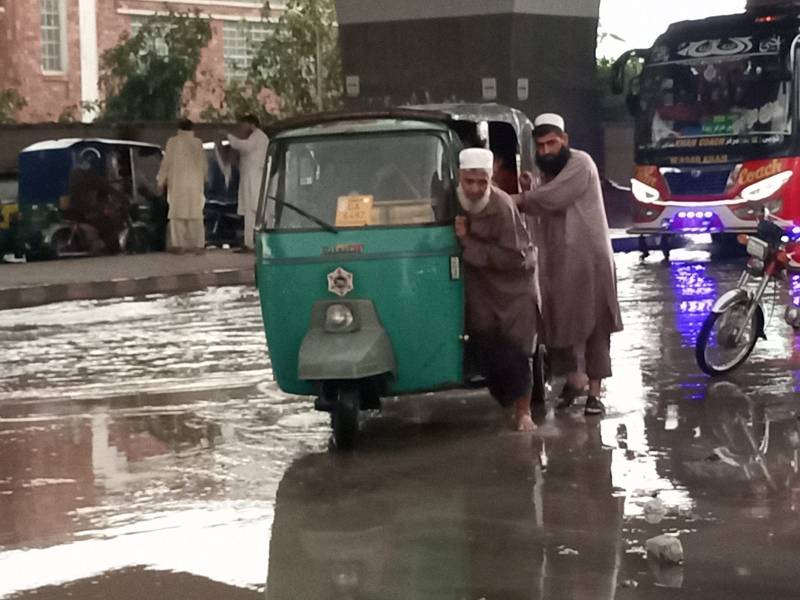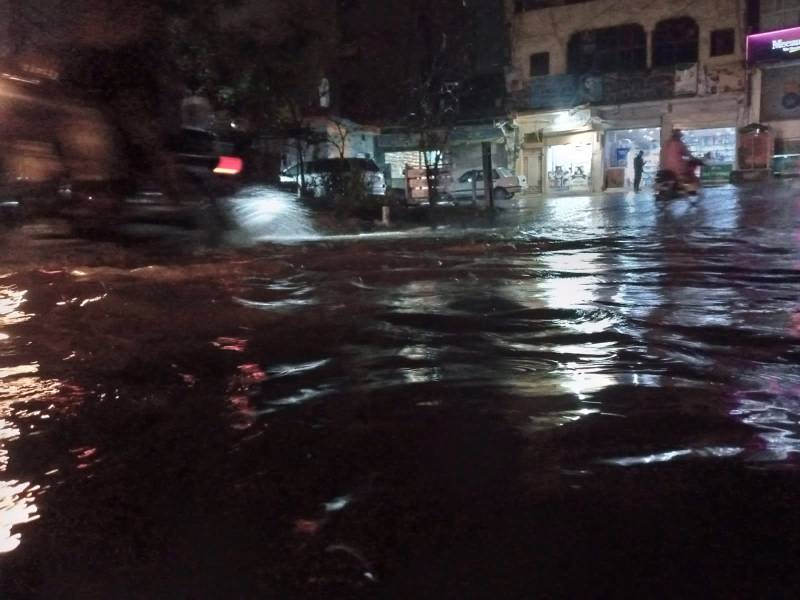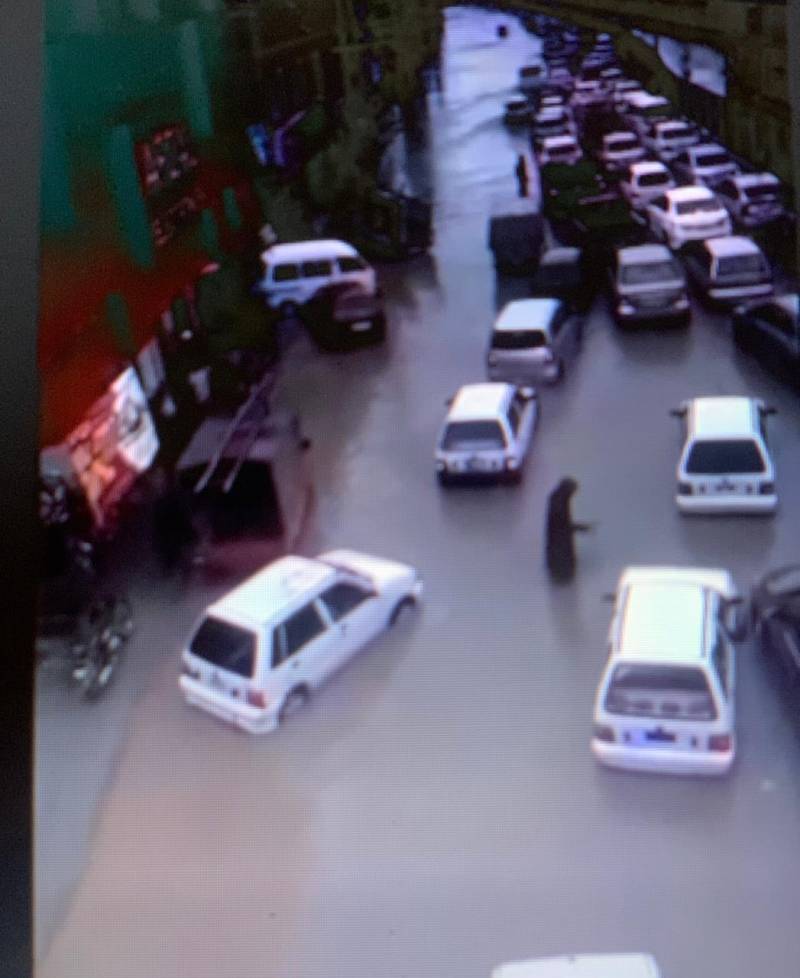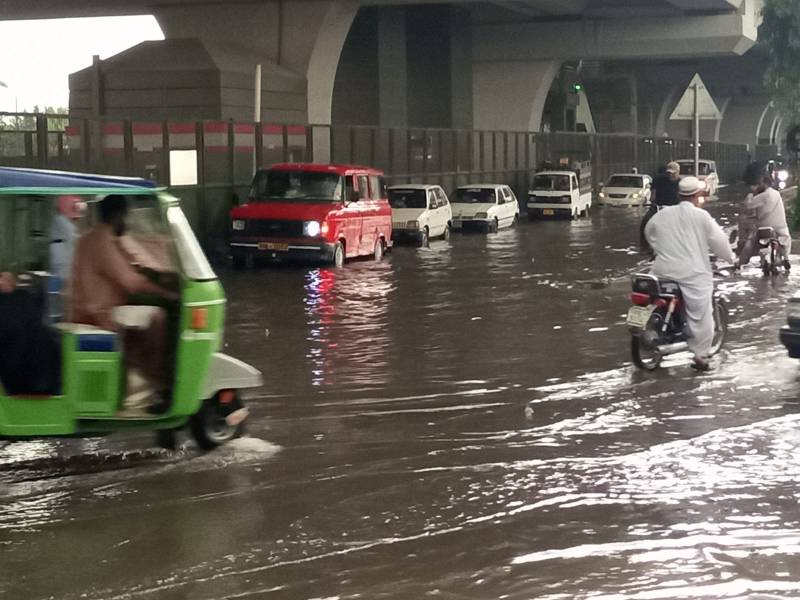
As the country jostled over the results of the February 8 elections, the northwestern provincial capital of Peshawar welcomed rains in the city. Considered to be the last rains of the long, cold winter, residents expected it would offer them respite from the smog for a few days at least. What they did not expect was for the rainwater to drown thoroughfares and render several areas inaccessible.
The situation forced many to reconsider their decision to vote the way they did and whether the incoming government—which earned a heavy mandate—would be able to resolve this issue.
Urban flooding
Rains began in Peshawar on February 19, and residents finally got to breathe some fresh air without smog. Breathing unhealthy air in this historic city is no longer odd for citizens during winter. Peshawar is the fourth-most polluted city in Pakistan, and the average life expectancy of a resident has been reduced by 3.9 years.
While February rains are not uncommon for Peshawar, the rains on February 19 and between February 29 and March 2 were far greater than what the city is used to. Consequently, several areas of the city reported urban flooding. Rainwater stood for hours before being drained, confining residents to their homes. The electricity supply system was also disrupted in many areas of the city.
Abdul Baseer Qalandar, who lives with his family in Gulberg Town, Peshawar, said that on March 1, the main thoroughfare in his neighbourhood was completely flooded. The situation was such that his daughter could not go to school that day. Qalandar said it took the civic authorities around eight hours to drain the roads and streets of water.
He added that whenever it rains for a day or more, roads in densely populated areas of the city, including Nothia, University Road, Gulbahar and Gulberg, disappear under 10 inches of water for hours.

As entire sections of major thoroughfares drown, traffic is diverted to the few alternative routes available, causing congestion. Even the city's Bus Rapid Transit (BRT) service, which operates on a dedicated track, faces disruptions and delays due to the water flooding its tracks.
He lamented that a day's rain in Peshawar had exposed the city's unplanned development and poor drainage.
Climate change impacting rain patterns
According to the Pakistan Meteorological Department (MET), this year, the winter rains and snowfall started quite late in Khyber Pakhtunkhwa (KP).
Officials said that Peshawar usually experiences light showers spread over several days at the confluence of winter and spring in February. This year, however, rain, typically expected over three to five days, was experienced within a few hours, flooding the city and its narrow waterways.
A MET official said that Pakistan's rainfall pattern has become increasingly erratic and intense over the past 15 years. Now, light rains, which are usually expected over four days, can fall in as little as four hours, greatly enhancing the risk of urban flooding in Pakistan's major cities.
Planning in Peshawar city
While climate change is affecting the intensity and pattern of rains in the city, residents and administrators of Peshawar are learning that the sewerage system built over centuries in the historical city is unable to keep up with the higher rainfall.
Government officials and subject experts point out that one of the biggest issues is the civic administration's failure to ensure that existing sewerage and drainage systems are free of encumbrances and can operate optimally during storms.
One reason for this is the population boom that Peshawar has witnessed over the past 20 years and, with it, the rampant and unplanned development that has encroached upon traditional waterways, designated sewerage systems, and storm drains.
Peshawar's population exploded from 2.027 million for the district (982,816 for urban areas) in 1998 to more than doubling to 4.267 million (including 1.969 million for urban areas) by 2017 at an average growth rate of 3.99. Its current population density is around an average of 3394.75 people per square kilometre.
The Water and Sanitation Services of Peshawar (WSSP), which is responsible for ensuring the availability of clean drinking water, maintaining sewage lines, and disposing of solid waste, admitted that the city faces a drainage issue.
WSSP Spokesperson Hasan Ali told The Friday Times that while there are various reasons for urban flooding in Peshawar, the biggest one is encroachment.
Ali said they had identified at least 2,400 locations across Peshawar where the main drainage systems of Peshawar have been encroached upon, whether by private builders, individuals or even by the government itself.
Another issue is the capacity of the drains, most of which were built when the city's population was quite modest.
With the city's population exploding and encroachments creating choke points, Ali said the city's installed drainage infrastructure simply cannot handle the flow of water and waste, especially during heavy rains. Consequently, the water patiently accumulates on the roads for hours, waiting for sufficient clearance in the drains to develop.
In response to a question, Ali conceded that the design of the sewage system is flawed, adding that flow is also an issue for solid waste, which requires regular cleaning of the drains by the WSSP.
He, however, argued that the issue of urban flooding and drain clearance requires other relevant departments to play their roles as well.
Peshawar's master plan
Peshawar is one of the oldest cities in Pakistan. Over time, a host of administrative services and drainage systems have been introduced here, from manual systems to modern mechanised systems. In fact, Peshawar sits atop a complex mesh of small and large drains.
The drainage system hinges on three large drains, including the Shahi Katha, Muhammad Zai and Hazar Khawani. Of these, the Shahi Katha is among the oldest. It was built around 200 years ago when the great Sikh ruler, Maharaja Ranjit Singh, counted Peshawar among his domains.

Ali explained that developing, cleaning and maintaining these three drains is a complex issue. Due to various administrative and territorial jurisdictions, these drains are maintained at various points by the Tehsil Municipal Administration (TMA), the Peshawar Development Authority (PDA), the WSSP and the local government.
How legal and illegal buildings surround these drains adds to the complexity of maintaining them.
A report compiled by the Capital Metropolitan (formerly known as the City District Government) found that over the past 100 years, some 239 government and 234 private buildings have been constructed atop the Shahi Katha drain alone.
No one at the helm?
While there may be a realisation among some in the relevant departments about the complex and climate change-induced drainage challenges facing the city, the problem is that this concern is not reflected on the ground. Currently, no project is underway to expand the city's drains to a level that accounts for the explosive growth of the city's population and adapts to the changed climate. The issue of illegal buildings and encroachment also remains largely unaddressed.
Over the past decade, three master plans were developed for the city to address encroachment and drainage, but none of them were implemented.
The last elected government of Khyber Pakhtunkhwa approved the "City Improvement Project" at a cost of Rs99 billion. The project includes a water supply and drainage project, the construction of green belts, and solid waste management systems in Abbottabad, Kohat, Mardan, Mingora (Swat), and Peshawar, with $200 million in support from the Asian Infrastructure Investment Bank (AIIB).
It remains to be seen when the new government, led by Ali Amin Gandapur, implements this project.
Regarding sustainable development in Peshawar, a government official, who spoke with The Friday Times on the condition of anonymity for fear of retribution, said that the main reason for the failure of the master plans in Peshawar is the lack of a strong link between departments.
The official said despite the existence of relevant laws, some 155 illegal housing societies have sprung up in and around Peshawar to house the city's rapidly expanding population. He further said that no consideration has been given to widening the 100-year-old drains.
Illegal encroachment in Peshawar
Dr Habib Jan, a Deputy Director at the Environmental Protection Agency (EPA) in Peshawar, told The Friday Times that Peshawar's population has doubled in the past 20 years, leading to a spike in construction activity around the city. Consequently, he said Peshawar is full of illegal buildings and housing societies, and the implementation of environmental laws is a serious issue.

The EIA official said that per their guidelines, all buildings and structures constructed in the city must be subject to Environmental Impact Assessments (EIA), and it is imperative for builders to obtain permission for the structures they are constructing, whether in the public or the private domain. In some cases, where the project is large enough to impact many people, Jan said public hearings on environmental concerns are held.
Jan said that the growth of unplanned and illegal construction around the city has made it prone to urban flooding and other climate disasters. Moreover, he said that Peshawar is threatened by the changing patterns of rain, water scarcity, and an increase in water-borne diseases. Peshawar is in the grip of a climate crisis, he stressed. Jan added that Peshawar is an unplanned city that needs an integrated master plan in light of climate change mitigation and adaptation strategies.
Addressing human faults
Qalandar said that the Pakistan Tehreek-e-Insaf (PTI) has been in government in Khyber Pakhtunkhwa for the past nine years. Despite its concern for climate change, its government in the province has not paid attention to its issues. Qalandar was of the view that the ministers who were put in charge of the provincial environment ministry were not competent.
However, he said it was too early to judge the recently appointed KP Climate Change, Forestry, Environment, and Wildlife Minister Fazal Hakim Khan. He did, however, note that Hakim has not demonstrated any experience in this area in the past.
Environmental experts and activists have questioned the efficacy and practicality of the government's plans for Peshawar's sustainable development and adaptability to climate change-induced hazards. They said that urban flooding is a serious problem in Peshawar, along with rapid encroachment and the effects of climate change becoming evident.
Shafeeq Gigyani, a human rights activist based in Khyber Pakhtunkhwa and the co-founder of the nonprofit organisation The Enlight Lab (TEL), told The Friday Times that Peshawar currently exhibits several symptoms of municipal mismanagement and unpreparedness to withstand climate change induced shocks including unplanned development, encroachment, an increase in threats to public health amid insufficient health infrastructure in the form of smog and other diseases.
He claimed that work on the city's sewage and drainage systems, especially in the context of climate change, has thus far been limited to official documents only. Gigyani further claimed there is a lack of collaboration and coordination between different government departments in Peshawar, which is why no development plan has been effectively implemented, let alone succeeded. Every department, he claimed, has been eager to present its proposal on solutions, but none have been willing to accept responsibility for implementing them. He further argued that the master plans proposed for Peshawar do not account for ground reality.
Contending that climate change is the biggest issue of our time, he said that due to climate change, Peshawar is witnessing frequent and intense rainstorms, increasing the risk of urban flooding. However, he lamented that Peshawar has not been developed to withstand these issues and has turned into a paved city that has lost its once fabled green character (one interpretation of the Sanskrit word 'Poshapura', the origins of the city 'Peshawar', is 'city of flowers').
Gigyani said that Peshawar is a historical city, but it is facing a climate change-induced crisis. Governance failures have seen it become the fourth-most polluted city in Pakistan, with smog an annual occurrence, where diseases are spreading rapidly, and its green cover has disappeared to give way to a concrete jungle. Keeping in view the environmental crisis and climate change, he said is a need for a comprehensive plan for Peshawar district where all stakeholders, departments are on the same page.

